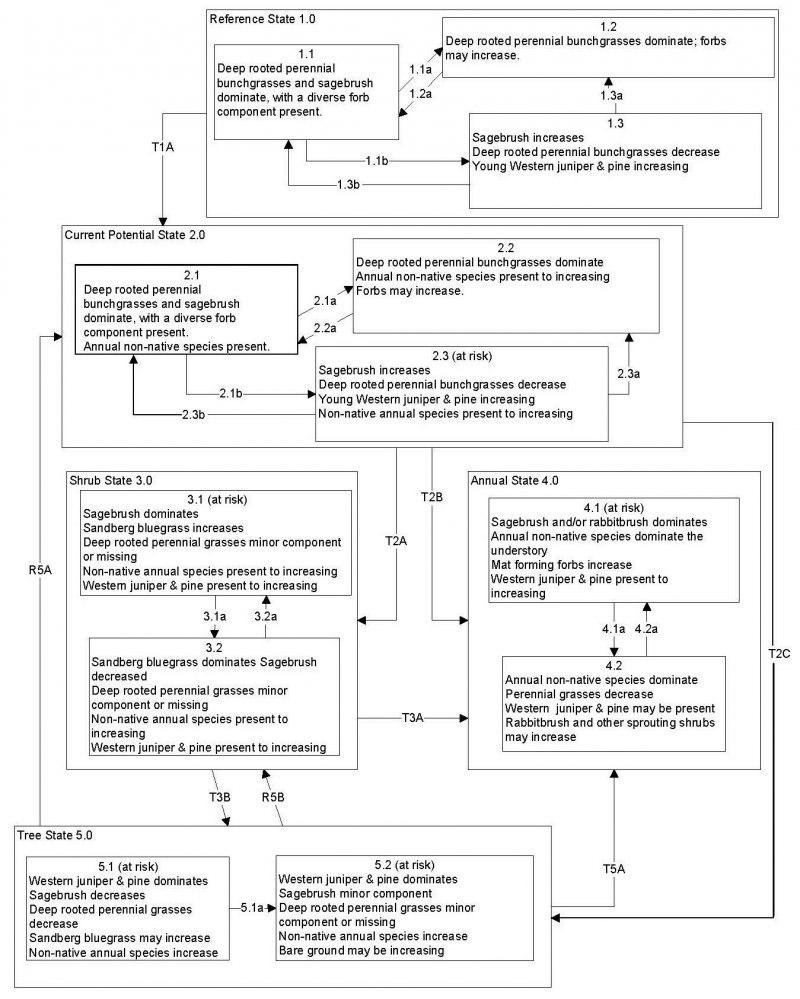
Natural Resources
Conservation Service
Ecological site R043CY804OR
Cool Mountain Bunchgrass (ARTRV/FEID)
Last updated: 4/04/2025
Accessed: 12/21/2025
General information
Provisional. A provisional ecological site description has undergone quality control and quality assurance review. It contains a working state and transition model and enough information to identify the ecological site.
MLRA notes
Major Land Resource Area (MLRA): 043C–Blue and Seven Devils Mountains
This MLRA covers the Blue and Seven Devils Mountains of Oregon, Washington and Idaho. The area is characterized by thrust and block-faulted mountains and deep canyons composed of sedimentary, metasedimentary, and volcanic rocks. Elevations range from 1,300 to 9,800 feet (395 to 2,990 meters). The climate is characterized by cold, wet winters and cool, dry summers. Annual precipitation, mostly in the form of snow, averages 12 to 43 inches (305 to 1,090 millimeters) yet ranges as high as 82 inches (2,085 millimeters) at upper elevations. Soil temperature regimes are predominately Frigid to Cryic and soil moisture regimes are predominately Xeric to Udic. Mollisols and Andisols are the dominant soil orders. Ecologically, forests dominate but shrub and grass communities may occur on south aspects and lower elevations as well as in alpine meadow environments. Forest composition follows moisture, temperature and elevational gradients and typically ranges from ponderosa pine and Douglas-fir plant associations at lower elevations, grand fir at middle elevations and subalpine fir and Engelman spruce at upper elevations. Historical fire regimes associated with these forest types range from frequent surface fires in ponderosa pine - Douglas Fir forest types to mixed and stand replacing fire regimes in grand fir and subalpine fir types. A large percentage of the MLRA is federally owned and managed by the U.S. Forest Service for multiple uses.
Classification relationships
Plant Assoc. of Blue and Ochoco Mountains (R6 E TP-036-92)
western juniper/Idaho fescue-bluebunch wheatgrass - CJG111
western juniper/mountain big sagebrush/Idaho fescue-bluebunch wheatgrass - CJS2
western juniper/bitterbrush/Idaho fescue-bluebunch wheatgrass - CJS321
mountain big sagebrush/Idaho fescue-bluebunch wheatgrass - SD2911
mountain big sagebrush/western needlegrass - SD2920
mountain big sagebrush/elk sedge - SS4911
USDA Forest Service Ecological Sub-region
M332 “Blue Mountains”
U.S. National Vegetation Classification Standard (NVCS)
Group: G304. Intermountain Mountain Big Sagebrush Steppe & Shrubland
Alliance: A3207. Artemisia tridentata ssp. spiciformis - Artemisia tridentata ssp. vaseyana Steppe & Shrubland Alliance
Association: Artemisia tridentata ssp. vaseyana / Festuca idahoensis Shrub Grassland
Ecological site concept
This site occurs on mountain slopes, hillslopes, plateaus and ridges of the Blue and Ochoco Mountains. Soils are typically moderately deep but range from shallow to very deep. Typically, total available water (either due to soil properties, or low precipitation) limits plant communities to drought resistant sagebrush and bunchgrass instead of large conifers. The reference state is characterized by a mix of mountain big sagebrush (Artemisia tridentata ssp. vaseyana), Idaho fescue (Festuca idahoensis) and perennial forbs. Minor amounts of western juniper (Juniperus occidentalis) and ponderosa pine (Pinus ponderosa) may be present. Typically, periodic low intensity fire removes woody species and favors deep rooted perennial bunchgrasses. Fire suppression favors invasion by western juniper and shrubs.
This is a provisional ecological site that groups characteristics at a broad scale with little to no field verification and is subject to extensive review and revision before final approval. All data herein was developed using existing information and literature and should be considered provisional and contingent upon field validation prior to use in conservation planning.
Associated sites
| R043CY808OR |
Claypan (ARAR8/FEID-PSSPS) Adjacent soils with well developed claypan layers favoring low sagebrush |
|---|
Similar sites
| R043CY802OR |
Cool foothills and Mountains (FEID-KOMA-PSSPS) Influenced by maritime climate patterns, ARTR uncommon |
|---|---|
| R043CY805OR |
Mountain Rockland (JUOC/CELE3/FEID) Greater large coarse fragment content, shallower soils with higher cover of cobbles and stones on the surface and areas of rock outcrop |
Table 1. Dominant plant species
| Tree |
Not specified |
|---|---|
| Shrub |
(1) Artemisia tridentata ssp. vaseyana |
| Herbaceous |
(1) Festuca idahoensis |
Click on box and path labels to scroll to the respective text.
Ecosystem states
States 2 and 5 (additional transitions)
| T1A | - | Introduction of non-native species |
|---|---|---|
| T2A | - | Less frequent fire and/or extended drought reduces perennial bunchgrasses and allows for an increase in shrub/tree species |
| T2B | - | Catastrophic fire; often coupled with soil disturbing activities and/or extended drought |
| T2C | - | Time and lack of disturbance allows for sagebrush to recover. Conifers may increase. |
| T3A | - | Catastrophic fire, multiple fires, and/or soil disturbing treatments/activities |
| T3B | - | Time and lack of disturbance allows for maturation of the tree community |
| R5A | - | Mechanical treatment of trees coupled with seeding of desired species |
| R5B | - | Mechanical treatment of trees |
| T5A | - | Catastrophic fire |

